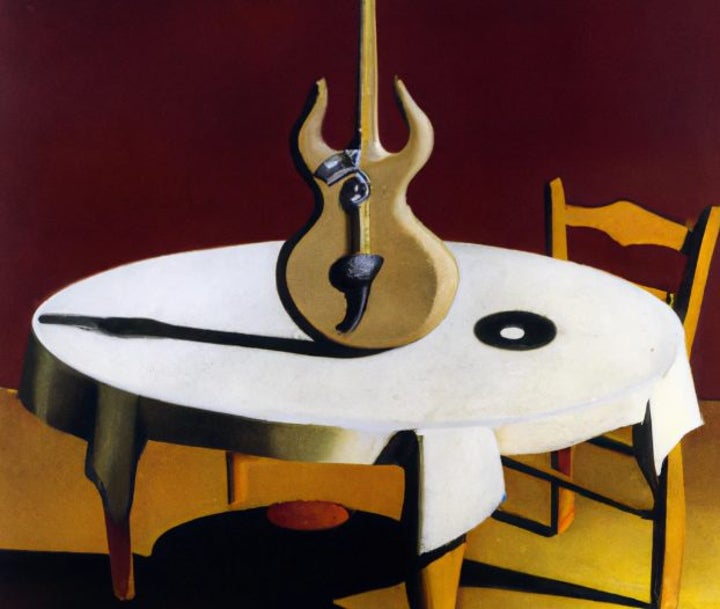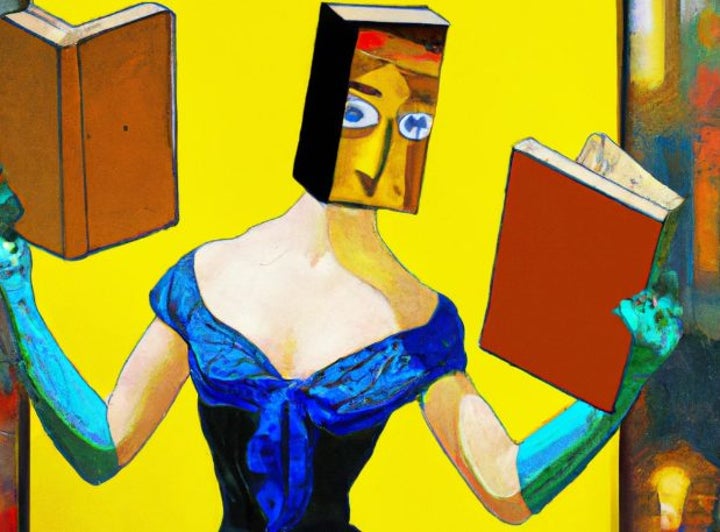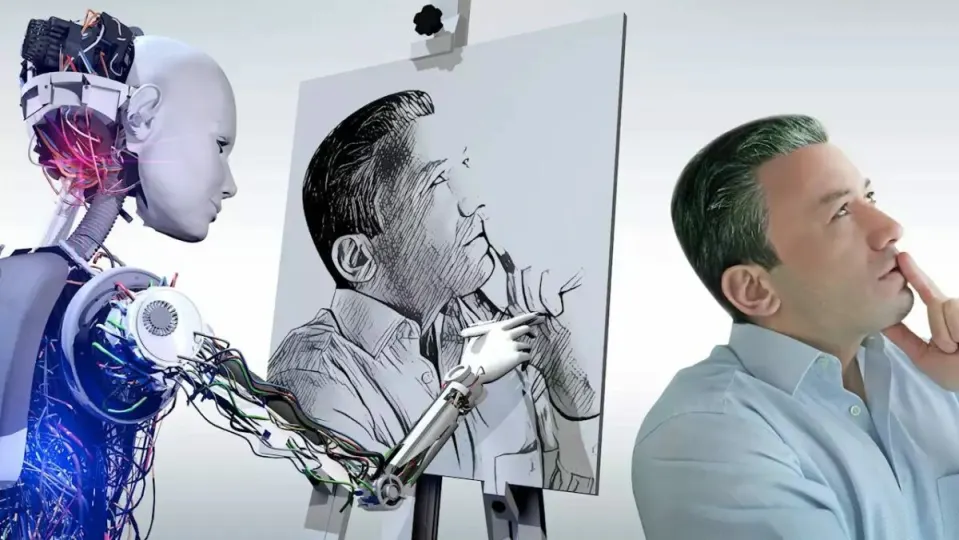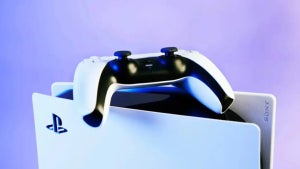This is a question that has been in the press a lot lately. However, even though there have been numerous lawsuits regarding whether AI-generated artwork is protected by copyright law, and, if so, which laws, we’re still no closer to an answer than we were. The following article will explore the various aspects of copyright law in terms of artwork and how it could apply to AI-generated art. We’ll also discuss whether AI is able to hold licensing for artworks, and if not, who the licenses should belong to.
As a nod to the brilliance of the artificially intelligent tools in question, every image in this article has been purposefully generated by Dall.E based on prompts relevant to the article’s subject matter.
Can AI own artwork?
We’re going to start off with a discussion about whether or not AI has the legal right to ownership of the artwork it creates. If Dall.E, for example, can own the image above even though I specified its composition, style, subjects, and overall message, the rest of the article would be moot.
As it turns out, though, a legal act from 2014 has already made the conditions necessary for copyright quite clear. Section 306 of the Compendium of U.S Copyright Office Practices, Third Edition, outlines the very clear human requirement. The section is even titled The Human Authorship Requirement. The following is a quote from the Act:
‘The U.S. Copyright Office will register an original work of authorship, provided that the work was created by a human being.’
This quote makes it clear that this copyright law protects ‘fruits of intellectual labor’ only if they are founded in the ‘creative powers of the mind,’ as was determined in the Trade-Mark Cases of 1879. This law, while established in 2014, has been enacted since the 1800s. In 1884, in the case of Burrow-Giles Lithography v. Sarony, the court resolved that ‘Because copyright law is limited to “original intellectual conceptions of the author,’ the Office will refuse to register a claim if it determines that a human being did not create the work.’
With the necessity of the human element defined, it seems clear that AI cannot own the artwork that it creates. But, if AI cannot own its work, who can? To answer that question, we first need to define the process by which an AI-generated artwork is created so that we can determine whether the works created are truly original.

What makes an artwork original?
Historically, artwork has always been a representation of something that the artist in question has seen, experienced, or desired. From the moment that man left an ochre handprint on the wall of a cave, we’ve had the desire to leave our mark on the world. In terms of visual artworks, this desire usually translates to the glorification of human subjects, capturing nature in our own hand, or using various visual media to transport viewers to various places.
Yes, some artwork is so abstract that it could only have come from a human mind, but more often than not, we either create artworks of people, man-made structures, or nature. This is usually accomplished by looking at a subject and trying to capture its perceived beauty. However, sometimes, we take heavy inspiration from other people’s creations.
To get around copyright infringement when replicating another artist’s work, the line of the day is that you need only change 10% of the artwork in order for it to be classified as an original piece. However, this is false. There is no amount by which you need to make alternations to a replication of an existing artwork so that it may be considered an original piece. Unfortunately, any replication or adaptation needs to be approved by the original author of the artwork. Without relevant permission from the relevant parties, you cannot claim authorship of an artwork based on someone else’s work.
The issue arises when we consider that this is exactly what AI can do. Artificial Intelligence doesn’t just create images out of the blue. It requires a reference library from which to create images. For example, if you instruct an AI to create a cubist image of a guitar on a table, it’ll take inspiration from famous cubist artists such as the author of Guitar on a Table, Juan Gris.
In fact, you can ensure that an artwork matches the style of a famous artist by using the phrase ‘A painting by X’ in your prompt. For example, here is the result of ‘A surrealist painting of a guitar on a table by Salvador Dali.’

This is near-indistinguishable from Dali’s surrealist works. At what point does an artwork directly inspired by a particular artist and movement become an original work of art? Seeing as I used ‘by Salvador Dali’ in the prompt, does that attribute the resultant work to Dali? These are aspects that we simply do not have the foundation to understand yet.
Luckily, according to Dall.E’s EULA, I am free to use this artwork wherever I want, even in an article that falls under commercial use. However, I didn’t make these strokes, I didn’t study Dali to get the feel of his works perfectly right, and I didn’t set a guitar on a table as a reference for the resultant artwork. All I did was type words into a prompt input field and press ‘generate.’ Is this really my artwork?
So far, we have determined that AI cannot own art, but we have yet to establish who owns the art that AI creates. We might never get to a common resolution on this point. However, some people have made strides in this particular battle, as we’ll explore in the next section.
The artist who owns AI-generated artworks
Kris Kashtanova is an artist based in New York. Kashtanova recently released a graphic novel featuring images created by latent diffusion AI. Kashtanova used the likeness of Zendaya in her prompts as she wanted her comic book’s main character to be based on the actress.
Recently, the managed to get her creation copyrighted. The comic book, Zarya of the Dawn, is therefore the first example of an AI-generated artwork to be licensed under copyright.
‘I got Copyright from the Copyright Office of the USA on my AI-generated graphic novel. I was open about how it was made and put Midjourney on the cover page. It wasn’t altered in any other way. Just the way you saw it here.
I tried to make a case that we do own copyright when we make something using AI. I registered it as visual arts work. My certificate is in the mail and I got the number and a confirmation today that it was approved.
My friend lawyer gave me this idea and I decided to make a precedent.’
Kashtanova’s actions have taken both the artistic and media communities by storm as this move may quite literally have set the precedent for how cases involving AI-generated artwork are handled going forward.
However, there still remains the issue of the name of this type of artwork; AI-generated. This means generated by Artificial Intelligence. These works were created by AI, do we really get to take credit for the work of a machine? If we think about all the other places where machines are involved in the process of creating products and providing services, it seems that, yes, we can take credit for the work of a machine.

Who owns AI-generated art?
The question still stands. The fact is that there are simply too many aspects that the Compendium of U.S Copyright Office Practices still needs to address. The only fact upon which we have managed to achieve some level of clarity is that AI cannot own artwork. Determining who owns the artwork generated by AI might need to be resolved on a case-by-case basis. For each instance, we’d need to determine:
- Whether the artwork is original or composed of existing artwork
- Who owns the rights to the artworks used in a composition
- Whether the artwork contains likenesses protected under copyright law
Down the line, depending on how widely and amicably this kind of advance is accepted into the artistic community, we may even need to determine whether this type of artwork can even be classified as artwork at all. The ability to create art is something we humans don’t attribute easily to other species. Yes, we can teach elephants to paint flowers with their trunks, but we have a unique ability to create expressions of the world around us and inside us. This ability is derived from the ability to see past the merely physical and attack figurative meaning to subjects, situations, and places, an ability that has a lot to do with consciousness itself.
In truth, before we can determine who owns the artwork that AI generates, we may need to determine whether AI has the ability to truly create works of art based on what it experiences, sees, and desires. Until then, it may be safer to think of these utilities as merely a paintbrush and a canvas, and the prompts as our hands moving across the canvas, creating representations of that which we experience, see, and desire.


